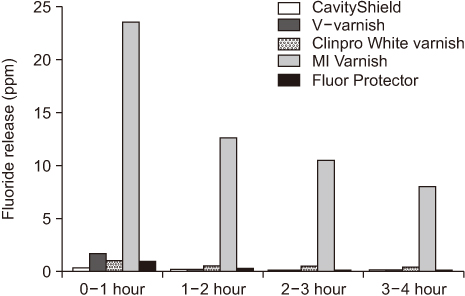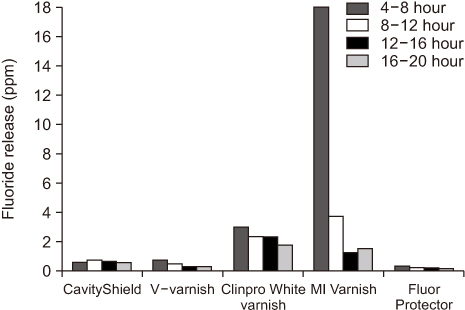J Korean Acad Oral Health.
2019 Dec;43(4):184-190. 10.11149/jkaoh.2019.43.4.184.
In vitro fluoride release from five different fluoride varnishes
- Affiliations
-
- 1Department of Preventive & Community Dentistry, School of Dentistry, Pusan National University, Yangsan, Korea. jsh0917@pusan.ac.kr
- KMID: 2467824
- DOI: http://doi.org/10.11149/jkaoh.2019.43.4.184
Abstract
OBJECTIVES
This study aims to compare the fluoride-release between different fluorine varnish under in vitro experimental conditions.
METHODS
In this study, 5 fluoride varnish products distributed in Korea were selected. V-varnishâ„¢ (Vericom, Korea: VV), CavityShieldâ„¢ (3M ESPE, USA: CS), Clinproâ„¢ White varnishâ„¢ (3M ESPE, USA: CP), MI Varnishâ„¢ (GC, Japan: MI), and Fluor Protector (Ivoclar Vivadent, Liechtenstein: FP). For the in vitro study, 10 mg of each fluoride varnish was thinly applied to the same area of the specimen. The specimen was then immersed in 3 ml of distilled water at consistent intervals to confirm fluoride release. Nine specimens per group were used. Fluoride ion electrodes were used to measure the fluoride concentration of the solution. The Kruskal-Wallis nonparametric test was performed to compare between each experimental group, and the Wilcoxon signed-rank nonparametric test was performed to compare experimental groups over time. The significance level for a Type I error was set at 0.05. All statistical analyses were performed using SPSS 25.0 (IBM Co., Armonk, NY, USA).
RESULTS
In vitro experiments showed that the amount of fluoride released from MI was higher than the other groups during the first 12 hours after application. However, the amount of fluoride released from CP and CS was higher than MI as the immersion time increased over 12 and 20 hours, respectively. The fluoride release from FP was the lowest at all measurement points.
CONCLUSIONS
The results of this study showed that the remaining fluoride effect from rosin type fluoride varnishes was higher than liquid type fluoride varnishes. There were differences in the residual fluoride concentrations despite each fluoride varnish having the same fluoride content.
MeSH Terms
Figure
Reference
-
1. Fejerskov O, Cury JA, Tenuta LM, Marinho VC. Fluorides in caries control. In : Fejerskov O, Nyvad B, Kidd E, editors. Dental caries: the disease and its clinical management. 3rd ed. Oxford: Wiley Blackwell;2015. p. 245–276.2. Featherstone JDB, Ten Cate JM. Physicochemical aspects of fluoride-enamel interactions. In : Ekstrand J, Fejerskov O, Silverstone LM, editors. Fluoride in dentistry. 2nd ed. Copenhagen: Munksgaard;1988. p. 125–149.3. Featherstone JD. Prevention and reversal of dental caries: role of low level fluoride. Community Dent Oral Epidemiol. 1999; 27:31–40.
Article4. Beltrán-Aguilar ED, Goldstein JW, Lockwood SA. Fluoride varnishes. A review of their clinical use, cariostatic mechanism, efficacy and safety. J Am Dent Assoc. 2000; 131:589–596.5. Øgard B, Seppä L, Rølla G. Professional topical fluoride applications-clinical efficacy and mechanism of action. Adv Dent Res. 1994; 8:190–201.6. Marinho VC, Worthington HV, Walsh T, Clarkson JE. Fluoride varnishes for preventing dental caries in children and adolescents. Cochrane Database Syst Rev. 2013; (7):CD002279. DOI: 10.1002/14651858.CD002279.pub2.
Article7. ten Cate JM, Featherstone JD. Mechanistic aspects of the interactions between fluoride and dental enamel. Crit Rev Oral Biol Med. 1991; 2:283–296.
Article8. Featherstone JD. Delivery challenges for fluoride, chlorhexidine and xylitol. BMC Oral Health. 2006; 6 Suppl 1:S8.
Article9. Ritwik P, Aubel JD, Xu X, Fan Y, Hagan J. Evaluation of short-term fluoride release from fluoride varnishes. J Clin Pediatr Dent. 2012; 36:275–278.10. Cochrane NJ, Shen P, Yuan Y, Reynolds EC. Ion release from calcium and fluoride containing dental varnishes. Aust Dent J. 2014; 59:100–105.
Article11. Virupaxi SG, Roshan NM, Poornima P, Nagaveni NB, Neena IE, Bharath KP. Comparative evaluation of longevity of fluoride release from three different fluoride varnishes–an in vitro study. J Clin Diagn Res. 2016; 10:ZC33–ZC36.12. Kim HN, Jeong MS, Kim SY, Kim JB, Jeong SH. Evaluation of release of fluoride from dental varnishes marketed in Korea. J Korean Acad Oral Health. 2014; 38:131–137.
Article13. Lee K, Lee S, Lee N, Jih M. A comparison of the amount of fluoride ion released and remineralization effect on the initial caries lesion of the various fluoride varnishes. J Korean Acad Pediatr Dent. 2016; 43:443–451.
Article14. Al Dehailan L, Lippert F, González-Cabezas C, Eckert GJ, Martinez-Mier EA. Fluoride concentration in saliva and biofilm fluid following the application of three fluoride varnishes. J Dent. 2017; 60:87–93.
Article15. Petersson LG, Twetman S, Pakhomov GN. The efficiency of semiannual silane fluoride varnish applications: a two-year clinical study in preschool children. J Public Health Dent. 1998; 58:57–60.
Article16. Seppä L, Tuutti H, Luoma H. Three-year report on caries prevention using fluoride varnishes for caries risk children in a community with fluoridated water. Scand J Dent Res. 1982; 90:89–94.
Article17. Seppä L, Pöllänen L. Caries preventive effect of two fluoride varnishes and a fluoride mouthrinse. Caries Res. 1987; 21:375–379.
Article18. van Eck AA, Theuns HM, Groeneveld A. Effect of annual application of polyurethane lacquer containing silane-fluoride. Community Dent Oral Epidemiol. 1984; 12:230–232.
Article19. Piesiak-Pańczyszyn D, Kaczmarek U. Fluoride release from fluoride varnish under in vivo and in vitro conditions. Dent Med Probl. 2017; 54:327–331.20. Shen C, Autio-Gold J. Assessing fluoride concentration uniformity and fluoride release from three varnishes. J Am Dent Assoc. 2002; 133:176–182.
Article21. Comar LP, Souza BM, Grizzo LT, Buzalaf MA, Magalhães AC. Evaluation of fluoride release from experimental TiF4 and NaF varnishes in vitro. J Appl Oral Sci. 2014; 22:138–143.
Article
- Full Text Links
- Actions
-
Cited
- CITED
-
- Close
- Share
- Similar articles
-
- Evaluation of release of fluoride from dental varnishes marketed in Korea
- Fluoride Release of Several Types of Fluoride-Containing Restorative Materials According to Fluoride Concentration in Toothpaste
- In vitro study on the fluoride release from glass ionomer cements and a fluoride-containing resin
- Fluoride Release and Recharge Properties of Several Fluoride-Containing Restorative Materials
- Effects of fluoride release and solubility of resin modified glass ionomer with surface coating agents




